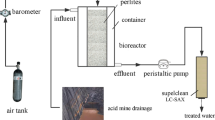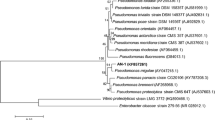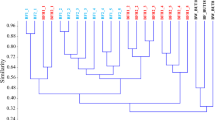Abstract
The formation and activity of aniline-degrading biofilms developed by the psychrotrophic Pseudomonas migulae AN-1 were studied for the in situ remediation of contaminated aquifer using in-well bioreactor of groundwater circulating wells (GCWs). Biofilms grown in mineral salt medium with aniline exhibited tolerance to high concentrations of aniline. In aniline degradation rate, AN-1 biofilms exhibited slight differences compared with planktonic cells. The effectiveness and bio-implication of AN-1 biofilms in GCWs were investigated to treat aniline-contaminated aquifer. The results demonstrate that AN-1 biofilms survived the GCWs treatment process with high aniline-degrading efficiency. This system provides a novel environmentally friendly technology for the in situ bioremediation of low-volatile contaminants.




Similar content being viewed by others
References
Allmon W, Everett L, Lightner A, Alleman B, Boyd T, Spargo B (1999) Groundwater circulating well technology assessment, Naval Research Laboratory. NRL/PU/6115-99-384, Washington, DC
Bazire A, Diab F, Jebbar M, Haras D (2007) Influence of high salinity on biofilm formation and benzoate assimilation by Pseudomonas aeruginosa. J Ind Microbiol Biotechnol 34:5–8
Blanford W, Barackrnan M, Boing T, Klingel E, Johnson G, Brusseau M (2001) Cyclodextrin-enhanced vertical flushing of a trichloroethene contaminated aquifer. Groundw Monit Remediat 21:58–66
Chakraborty J, Das S (2014) Characterization and cadmium-resistant gene expression of biofilm-forming marine bacterium Pseudomonas aeruginosa JP-11. Environ Sci Pollut Res Int 21:14188–14201
Davey ME, O’toole GA (2000) Microbial biofilms: from ecology to molecular genetics. Microbiol Mol Biol Rev 64:847–867
Elmore AC, Graff T (2002) Best available treatment technologies applied to groundwater circulation wells. Remediat J 12:63–80
Findlay RH, King GM, Watling L (1989) Efficacy of phospholipid analysis in determining microbial biomass in sediments. Appl Environ Microbiol 55:2888–2893
Gilbert P, Collier PJ, Brown M (1990) Influence of growth rate on susceptibility to antimicrobial agents: biofilms, cell cycle, dormancy, and stringent response. Antimicrob Agents Chemother 34:1865
Goltz MN, Gandhi RK, Gorelick SM, Hopkins GD, Smith LH, Timmins BH, McCarty PL (2005) Field evaluation of in situ source reduction of trichloroethylene in groundwater using bioenhanced in-well vapor stripping. Environ Sci Technol 39:8963–8970
Gorbushina AA, Broughton WJ (2009) Microbiology of the atmosphere-rock interface: how biological interactions and physical stresses modulate a sophisticated microbial ecosystem. Annu Rev Microbiol 63:431–450
Huang J, Goltz MN (2005) A three-dimensional analytical model to simulate groundwater flow during operation of recirculating wells. J Hydrol 314:67–77
Johnson RL, Simon MA (2007) Evaluation of groundwater flow patterns around a dual-screened groundwater circulation well. J Contam Hydrol 93:188–202
Lakhwala FS, Mueller JG, Desrosiers RJ (1998) Demonstration of a microbiologically enhanced vertical ground water circulation well technology at a Superfund site. Groundw Monit Remediat 18:97–106
Lazarova V, Manem J (1995) Biofilm characterization and activity analysis in water and wastewater treatment. Water Res 29:2227–2245
Lewis K (2007) Persister cells, dormancy and infectious disease. Nat Rev Microbiol 5:48–56
Li M, Peng L, Ji Z, Xu J, Li S (2008) Establishment and characterization of dual-species biofilms formed from a 3, 5-dinitrobenzoic-degrading strain and bacteria with high biofilm-forming capabilities. FEMS Microbiol Lett 278:15–21
Li C, Li Y, Cheng X, Feng L, Xi C, Zhang Y (2013) Immobilization of Rhodococcus rhodochrous BX2 (an acetonitrile-degrading bacterium) with biofilm-forming bacteria for wastewater treatment. Bioresour Technol 131:390–396
Liu J, Zhou XH, Shi HC (2012) Inhibitory effects of pentachlorophenol on wastewater biofilms as determined by phospholipid analysis and microelectrode. Biochem Eng J 66:8–13
Liu YB, Qu D, Wen YJ, Ren HJ (2015) Low-temperature biodegradation of aniline by freely suspended and magnetic modified Pseudomonas migulae AN-1. Appl Microbiol Biotechnol 99:5317–5326
Lyon DY, Vogel TM (2013) Bioaugmentation for groundwater remediation: an overview. In: Bioaugmentation for groundwater remediation. Springer, pp 1–37
Mangwani N, Shukla SK, Rao TS, Das S (2014) Calcium-mediated modulation of Pseudomonas mendocina NR802 biofilm influences the phenanthrene degradation. Colloids Surf B Biointerfaces 114:301–309
O’Neill FJ, Bromley-Challenor KCA, Greenwood RJ, Knapp JS (2000) Bacterial growth on aniline: implications for the biotreatment of industrial wastewater. Water Res 34:4397–4409
O’Toole GA, Pratt LA, Watnick PI, Newman DK, Weaver VB, Kolter R (1999) Genetic approaches to study of biofilms. Method Enzymol 301:91–109
Rabideau AJ, Blayden JM, Ganguly C (1999) Field performance of air-sparging system for removing TCE from groundwater. Environ Sci Technol 33:157–162
Rani SA et al (2007) Spatial patterns of DNA replication, protein synthesis, and oxygen concentration within bacterial biofilms reveal diverse physiological states. J Bacteriol 189:4223–4233
Sawai J, Ito N, Minami T, Kikuchi M (2005) Separation of low volatile organic compounds, phenol and aniline derivatives, from aqueous solution using silicone rubber membrane. J Membr Sci 252:1–7
Scheutz C, Durant ND, Broholm MM (2014) Effects of bioaugmentation on enhanced reductive dechlorination of 1, 1, 1-trichloroethane in groundwater: a comparison of three sites. Biodegradation 25:459–478
Shimada K, Itoh Y, Washio K, Morikawa M (2012) Efficacy of forming biofilms by naphthalene degrading Pseudomonas stutzeri T102 toward bioremediation technology and its molecular mechanisms. Chemosphere 87:226–233
Tribelli PM, Di Martino C, López NI, Iustman LJR (2012) Biofilm lifestyle enhances diesel bioremediation and biosurfactant production in the Antarctic polyhydroxyalkanoate producer Pseudomonas extremaustralis. Biodegradation 23:645–651
Watnick P, Kolter R (2000) Biofilm, city of microbes. J Bacteriol 182:2675–2679
Werner E et al (2004) Stratified growth in Pseudomonas aeruginosa biofilms. Appl Environ Microbiol 70:6188–6196
Acknowledgments
This work was financially supported by Key Project of National Natural Science Foundation of China (Grant No. 41530636), National Natural Science Foundation of China (Grant No. 41471252), and Scientific Frontier and Interdisciplinary Research Project of Jilin University, Outstanding Youth Cultivation Plan of Jilin University.
Author information
Authors and Affiliations
Corresponding author
Ethics declarations
Conflict of interest
The authors declare that they have no conflict of interest. This article does not contain any studies with human participants or animals performed by any of the authors.
Additional information
Responsible editor: Robert Duran
Electronic supplementary material
Below is the link to the electronic supplementary material.
ESM 1
(DOCX 1292 kb)
Rights and permissions
About this article
Cite this article
Zhao, Y., Qu, D., Zhou, R. et al. Efficacy of forming biofilms by Pseudomonas migulae AN-1 toward in situ bioremediation of aniline-contaminated aquifer by groundwater circulation wells. Environ Sci Pollut Res 23, 11568–11573 (2016). https://doi.org/10.1007/s11356-016-6737-7
Received:
Accepted:
Published:
Issue Date:
DOI: https://doi.org/10.1007/s11356-016-6737-7




